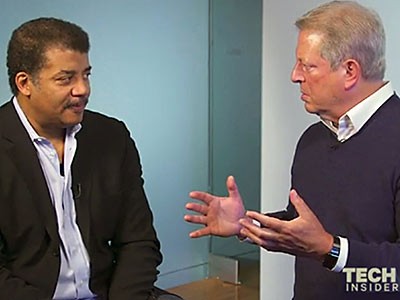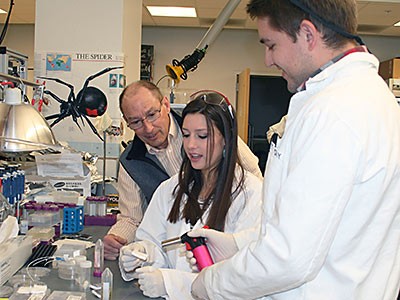Al Gore, Neil deGrasse Tyson Marvel at USU's Spider Silk Research
Astrophysicist and StarTalk Radio host Neil deGrasse Tyson, left, and former vice president Al Gore discuss USU's synthetic spider silk research during the April 11, 2016, episode of Tech Insider’s 'Innovators’ program. Courtesy Tech Insider.
When Al Gore and astrophysicist, science communicator-to-the-masses Neil deGrasse Tyson sat down for a chat on the April 11, 2016, episode of the latter’s “Innovators” program on Tech Insider’s StarTalk Radio Show, the topic turned to the ethics of biotechnology.
“You know about spider goats?” Gore asked.
“Sounds interesting,” Tyson replied.
The former vice president went on to describe Utah State University’s research, led by USTAR biology professor Randy Lewis, in genetically modifying goats to produce spider silk protein in their milk.
The two marveled at the technology and, while both agreed they were “okay” with this type of research, they urged caution with emerging genetic engineering.
“That gets creepy,” Tyson said.
Interestingly, “creepy” is exactly the word Gore frequently uses to describe a vague uneasiness many feel when confronted with rapid technological changes.
No, he isn’t making a clever pun about arachnids. Rather, in his recent book, The Future: Six Drivers of Global Change, Gore defines “creepiness” as “a comparably indeterminate ‘pre-fear’ that many feel when contemplating some of the onrushing advances in the world of genetic engineering.”
Creepy? Most people describe USU’s spider goats as “adorable.” In fact, Lewis makes an effort to display his goats in public as much as possible to demonstrate their “normalcy.” No one can tell the difference between the transgenic goats that have received spider silk genes and the non-transgenic goats that haven’t.
Even so, Lewis’ goats and the corresponding research continue to capture people’s imaginations. In addition to the transgenic ruminants, the USU professor also produces synthetic spider silk from transgenic alfalfa, silkworms and bacteria. He regularly fields media inquiries from the BBC, Associated Press, the Discovery Channel and more.
Named the College of Science’s 2016 Undergraduate Research Mentor of the Year, Lewis and his students are busily exploring a variety of future applications for his lab’s products. Undergrads Breton Day and Danielle Gaztambide recently presented findings on using the silk for gels, adhesives and coatings for medical implants at the 2016 Material Research Society Spring Meeting in Phoenix.
“Our silk solutions are made from just protein and water,” says Gaztambide. “They don’t cause an immune response or inflammation when used in the human body, which greatly reduces the risk of infection and offers a tremendous advantage over conventional materials.”
With a grant from the U.S. Army, the Lewis Lab is also investigating use of synthetic spider silk fabric to produce military clothing that doesn’t melt (and cause further injury) during searing temperatures wrought by explosive devices.
“Spider silk can produce fabric that’s lighter, stronger and stretchier than nylon,” Lewis says. “This could make a big difference to troops carrying heavy gear in harsh conditions. Plus, in a fire or explosion, it simply chars and breaks down.”
Additional potential applications for synthetic spider silk include lighter, stronger and safer vehicle air bags and body armor, as well as lighter and stronger vehicles with greater fuel efficiency and more resistance to collision damage.
Related links:
- “Spider Silk New Tool Against Infection say USU Undergrad Researchers,” Utah State Today
- “Spider Camo? USU Awarded Army Funds to Produce Heat-Resistant Fabric,” Utah State Today
- “USU-led Team Awarded $1.9M DOE Energy Efficient Transport Tech Grant,” Utah State Today
- USU Department of Biology
- USU College of Science
Contact: Randy Lewis, 435-797-9291, randy.lewis@usu.edu
Writer: Mary-Ann Muffoletto, 435-797-3517, maryann.muffoletto@usu.edu
USU College of Science Undergrad Research Mentor of the Year Randy Lewis, left, guides students Danielle Gaztambide and Breton Day in production of synthetic spider silk for medical applications.
TOPICS
Research 878stories Biology 165stories USTAR 64stories Spider Silk 19storiesComments and questions regarding this article may be directed to the contact person listed on this page.








